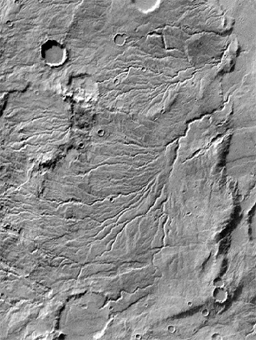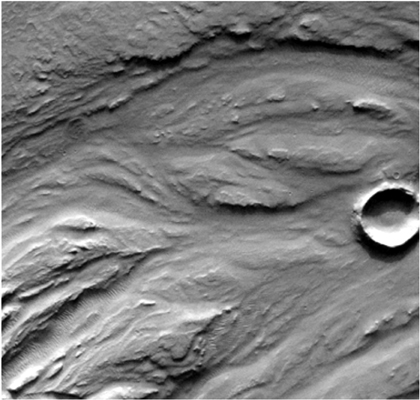Mars Geology
Flowing Water Features
Mars resembles Earth in a way that is unique among other planets in our solar system – many parts of its surface are marked by channels or other sinuous features that were likely formed by flowing water. There are three kinds of channels, which differ in their age and characteristics.
The oldest class of channels is called valley networks. These branching valleys occur in the southern highlands but are absent from the younger northern plains. So, they must be extremely ancient, about 3.8 billion years old or older. Their branching pattern is similar to that in river systems in Earth's most arid areas. Most scientists interpret the valley networks to be the valleys that formed along ancient systems of Martian rivers.

Valley networks are thought to be ancient river channels and their
surrounding valleys, that incise the southern highlands.
(Image credit NASA/JPL-Caltech.)
The second class of channels is known as outflow channels. These formed later during Martian history, but still billions of years ago. Most of them start at a fault zone or the breached rim of a crater or valley. Several of the largest outflow channels arise at the eastern end of Valles Marineris. Outflow channels are reminiscent of wide channels in Earth's channeled scablands in eastern Washington state, which were carved when water catastrophically burst from a large glacial lake. Many scientists think Mars' outflow channels formed similarly, when large lakes burst their shorelines or when groundwater pressure caused an aquifer to erupt violently to the surface.

Outflow channels are broad, winding, sculpted valleys cut by
catastrophic release of liquid water, or alternatively by ice.
(Image credit NASA/JPL-Caltech.)
The third, and most controversial, class of channels is called gullies. These occur mostly at mid-latitudes. They are very young, lacking superimposed craters. Some gullies are located on the walls of craters and tectonic troughs (grabens) and were first interpreted as having formed from discharge of modern ground water or the melting of snow that accumulated thousands of years ago when Mars' climate was different. However some gullies occur on sand dunes, which are not believable modern water sources, and they change year-to-year indicating active processes. Some recent studies show that gullies occur preferentially where seasonal carbon dioxide frost forms, with gully formation likely driven by water-free processes such as ablation of the carbon dioxide frost.

Gullies formed on crater and valley walls during Mars' most recent history.
(Image credit NASA/JPL/Malin Space Science Systems.)
The most recently recognized class of sinuous features possibly formed by water is called “recurring slope lineae,” or RSLs. RSLs lack topographic relief and so are not channels, strictly speaking. Instead they are dark streaks that form in spring on sunny slopes, grow in a downslope direction over the spring and summer, and then fade in late summer. They grow at times and places where surface temperate is near or above the freezing point of water. They have all the characteristics expected for thin films of very salty water that creeps down warm slopes over the summer.

This enhanced-color image shows a slope covered by dark, reddish "recurring slope lineae".
(Image credit NASA/JPL/University of Arizona.)
